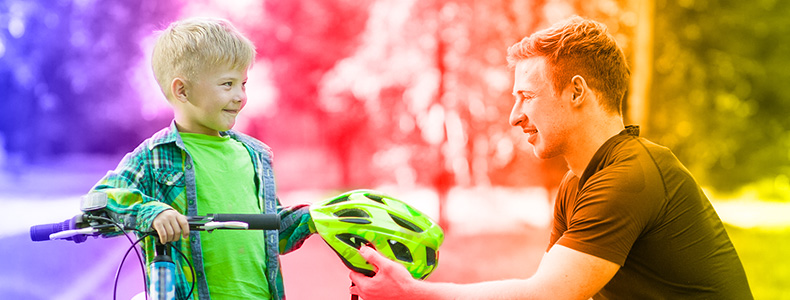With about 80 million bicyclists sharing the road with motor vehicles, it’s important for bike riders and drivers to take safety precautions.
This is where the importance of learning the fundamentals of riding for first time bicyclists comes in. Even if you’re an experienced rider, it’s still beneficial to periodically review these rules of the road.
The Fundamentals of Bike Riding
For some kids, it can be difficult to determine what is and isn’t an emergency. It may be helpful to teach kids the difference between something being dangerous, such as cleaning supplies left unattended, and someone being hurt, such as if a sibling were to ingest those cleaning supplies. They also should know how to identify the potential for someone to be hurt, such as when there is a fire in the home.
When it comes to ensuring a safer ride, the best guideline is to be alert, be wary, and be seen.1
- Be alert – Scan the street in front of you, left, and right
- Be wary – Keep your eye out for vehicles, pedestrians, and others distractions on the road
- Be seen – In order to be seen by others, use your horn, hand signals, and lights
Tips for a Safer Ride
There are multiple actions you can take in order to have a safer ride.
These actions include:1
- Wearing your helmet
- Keeping your head up and looking ahead, not at the ground
- Only having one person per bike
- Riding single file with a space between each bike
- Riding on the right side of the road and never against traffic – to help lower the risk of getting in an accident, and to lessen your chances of getting a ticket
- Planning your route ahead of time if you’re riding with a group, and planning what to do in the event you’re separated by traffic
- Making sure to look up local laws and rules beforehand, if you’re riding in an unfamiliar area
- Avoiding busy roads and peak traffic times on your route, if possible
- Before going on a night ride, if possible, asking someone to help check your visibility to motorists, and wearing reflective gear
- Maintaining bikes in your household – this means keeping chains clean and periodically inspecting brake pads, checking your air pressure in tires, and making sure your seat, handlebars, and wheels fit tightly2
- Crossing at intersections2
- Using bike lanes whenever you can2
- Not riding too close to parked cars2
- Always passing to the left side of bikers or other people on the street, and calling out, “On your left!” so they know you’re coming2
Additionally, learning proper hand signals is important for helping to safely maneuver on the road. It’s important to understand the correct signals for turning, stopping, and changing lanes.1
Hazard Recognition
In addition to incorporating tips for a safer ride, knowing any potential road hazards will help keep you safer as well.
There are multiple road hazards you’ll want to look out for when riding. One hazard is uneven, rough surfaces.1 Surfaces such as these can cause you to lose control of your bicycle, and can lead to an accident.
Also, objects in the road can cause flat tires, loss of balance, or unsafe maneuvers.1 In order to help protect yourself, avoid riding across unknown objects to the best of your ability.
Finally, avoid slippery surfaces, as they can cause a loss of traction.1
Tips to Avoid Collisions
There are multiple preventative measures you can take, in order to help avoid collisions.
Some tips you’ll want to abide by to increase your chances of a safer ride include:1
- Not wearing headphones
- Keeping both hands on handlebars, except when signaling
- Keeping both feet on pedals
- Riding single file in a group, with the flow of traffic
- Wearing a brightly colored helmet and reflective gear
- Using correct hand signals
- Avoid riding at twilight or in the dark if possible, especially on narrow roads with speed limits that exceed 35mph
- https://one.nhtsa.gov/people/injury/pedbimot/bike/kidsandbikesafetyweb/index.htm
- https://kidshealth.org/en/kids/bike-safety.html
- https://www.nsc.org/home-safety/tools-resources/seasonal-safety/summer/bicycles
Categories: Child Safety Ages 4-11, Travel Safety
